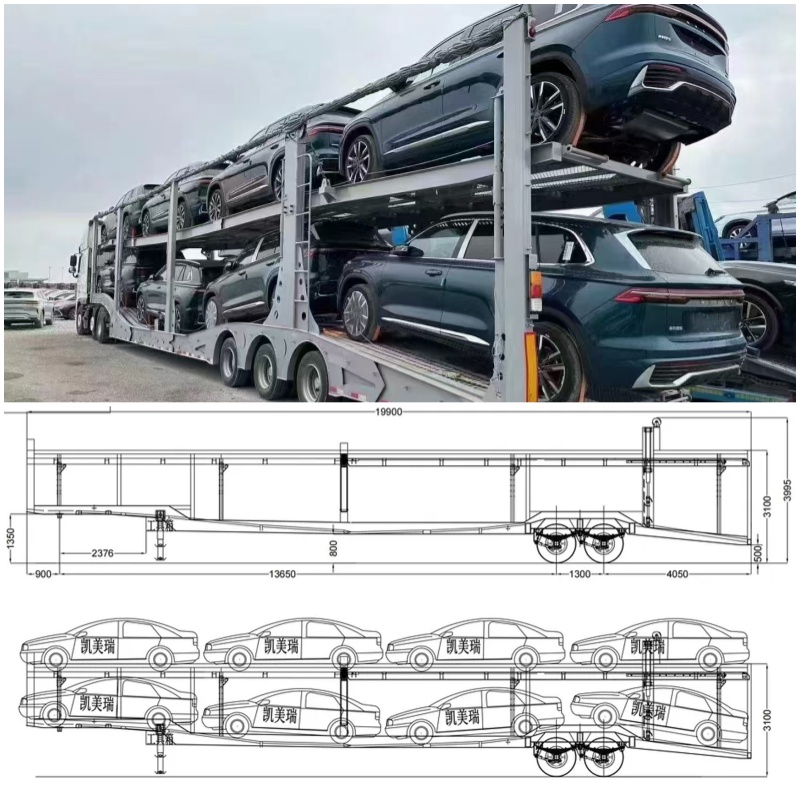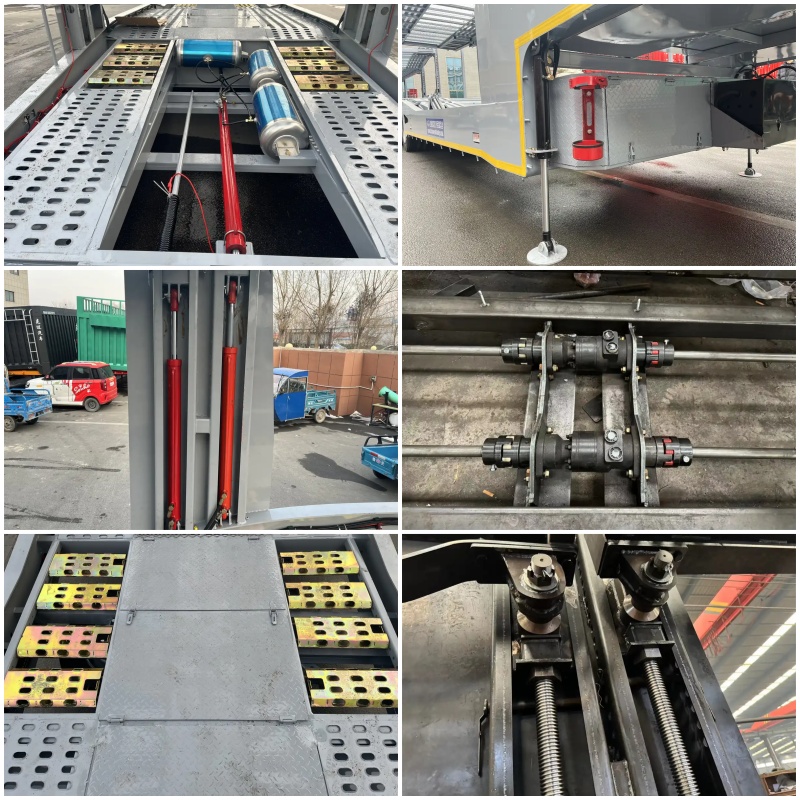| Availability: | |
|---|---|
| Quantity: | |
The 6 Car Carrier Semi Trailer is designed for the efficient transportation of up to six passenger vehicles, typically sedans, SUVs, or small vans. Also known as an Auto Transport or Carrier trailer, it features a multi-level deck system (usually bi-level, sometimes tri-level) to maximize cargo space within legal height and length restrictions. Constructed from high-tensile steel, it incorporates hydraulic or mechanical ramps for vehicle loading and unloading.
1.Can holds up to 6 vehicles depending on size and configuration.Suitable for sedans, SUVs, and small trucks.
2.Design with two-deck configuration for maximizing space.
3.Equip with hydraulic ramps for loading and unloading vehicles easily.
4. Multi decks are adjustable to accommodate different vehicle sizes.
5. Equipped with hydraulic lift systems to adjust deck heights.Ramps and tie-downs to secure vehicles during transport.
6. Safety Features:
Adopt anti-slip flooring for secure loading.
Use multiple tie-down points and straps to prevent vehicle movement.
Equipped with brake systems and reflective markings for road safety.

Type | Car trailer |
Axles | 2 /3 Axles*13Ton,FUWA/BPW |
Size | 13750*2550*4000 mm |
Main Bream | Height: 300mm,Top Flange: 10mm,Under Flange: 10mm,Middle Flange: 8mm,Material: T700 |
Floor | The First and Second Floor Runway Is Paved With Anti-Skid Plate |
Braking System | Air Dual braking system,with relay valve |
Suspension | Mechnical Suspension |
Landing gear | 28 Tons Two Speed,JOST |
Multi-Level Deck System: Primarily bi-level design (upper and lower deck), with some models offering a collapsible third level or hydraulic folding decks to accommodate taller vehicles on the lower level.
Hydraulic Loading Ramps: Integrated hydraulic ramps or tilting decks facilitate safe and efficient self-loading/unloading of vehicles by drivers.
Vehicle Securement: Equipped with numerous integrated winch points, wheel straps (nylon or chain), and winches to securely fasten each vehicle during transit, preventing movement.
Durability & Safety: Robust steel framework, anti-slip deck surfaces, safety chains, lighting, and often breakaway systems. Deck heights and widths are optimized for vehicle clearance.
Accessibility: Decks are adjustable (manually or hydraulically) to accommodate various vehicle heights. Rear and side access points allow loading flexibility.
Used by auto manufacturers, car dealerships, vehicle rental agencies, auction houses, and specialized auto transport companies to move multiple vehicles simultaneously over road networks. Essential for new car delivery and used vehicle relocation.
Q: Can all 6 positions carry SUVs or trucks?
A: Deck height adjustments allow taller vehicles (SUVs, some trucks) primarily on the lower deck. Upper deck height limits typically restrict it to sedans or lower-profile vehicles. Configurations vary.
Q: How are vehicles secured?
A: Each vehicle position has dedicated anchor points. Vehicles are secured using wheel straps that bind the tires to the deck, often supplemented by winch lines attached to the chassis.
Q: What is the loading/unloading process?
A: Drivers typically drive the vehicles onto the trailer using the integrated ramps. Hydraulic systems may tilt the entire deck or deploy ramps. Winches are used if a vehicle is inoperable.

The 6 Car Carrier Semi Trailer is designed for the efficient transportation of up to six passenger vehicles, typically sedans, SUVs, or small vans. Also known as an Auto Transport or Carrier trailer, it features a multi-level deck system (usually bi-level, sometimes tri-level) to maximize cargo space within legal height and length restrictions. Constructed from high-tensile steel, it incorporates hydraulic or mechanical ramps for vehicle loading and unloading.
1.Can holds up to 6 vehicles depending on size and configuration.Suitable for sedans, SUVs, and small trucks.
2.Design with two-deck configuration for maximizing space.
3.Equip with hydraulic ramps for loading and unloading vehicles easily.
4. Multi decks are adjustable to accommodate different vehicle sizes.
5. Equipped with hydraulic lift systems to adjust deck heights.Ramps and tie-downs to secure vehicles during transport.
6. Safety Features:
Adopt anti-slip flooring for secure loading.
Use multiple tie-down points and straps to prevent vehicle movement.
Equipped with brake systems and reflective markings for road safety.

Type | Car trailer |
Axles | 2 /3 Axles*13Ton,FUWA/BPW |
Size | 13750*2550*4000 mm |
Main Bream | Height: 300mm,Top Flange: 10mm,Under Flange: 10mm,Middle Flange: 8mm,Material: T700 |
Floor | The First and Second Floor Runway Is Paved With Anti-Skid Plate |
Braking System | Air Dual braking system,with relay valve |
Suspension | Mechnical Suspension |
Landing gear | 28 Tons Two Speed,JOST |
Multi-Level Deck System: Primarily bi-level design (upper and lower deck), with some models offering a collapsible third level or hydraulic folding decks to accommodate taller vehicles on the lower level.
Hydraulic Loading Ramps: Integrated hydraulic ramps or tilting decks facilitate safe and efficient self-loading/unloading of vehicles by drivers.
Vehicle Securement: Equipped with numerous integrated winch points, wheel straps (nylon or chain), and winches to securely fasten each vehicle during transit, preventing movement.
Durability & Safety: Robust steel framework, anti-slip deck surfaces, safety chains, lighting, and often breakaway systems. Deck heights and widths are optimized for vehicle clearance.
Accessibility: Decks are adjustable (manually or hydraulically) to accommodate various vehicle heights. Rear and side access points allow loading flexibility.
Used by auto manufacturers, car dealerships, vehicle rental agencies, auction houses, and specialized auto transport companies to move multiple vehicles simultaneously over road networks. Essential for new car delivery and used vehicle relocation.
Q: Can all 6 positions carry SUVs or trucks?
A: Deck height adjustments allow taller vehicles (SUVs, some trucks) primarily on the lower deck. Upper deck height limits typically restrict it to sedans or lower-profile vehicles. Configurations vary.
Q: How are vehicles secured?
A: Each vehicle position has dedicated anchor points. Vehicles are secured using wheel straps that bind the tires to the deck, often supplemented by winch lines attached to the chassis.
Q: What is the loading/unloading process?
A: Drivers typically drive the vehicles onto the trailer using the integrated ramps. Hydraulic systems may tilt the entire deck or deploy ramps. Winches are used if a vehicle is inoperable.
